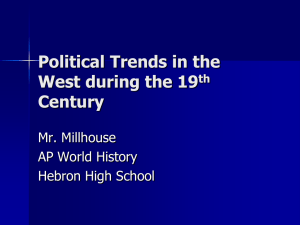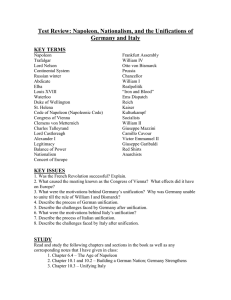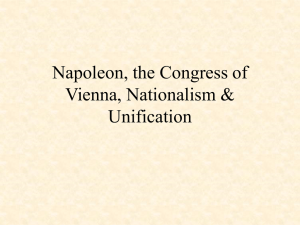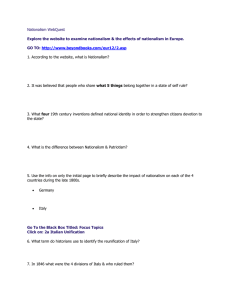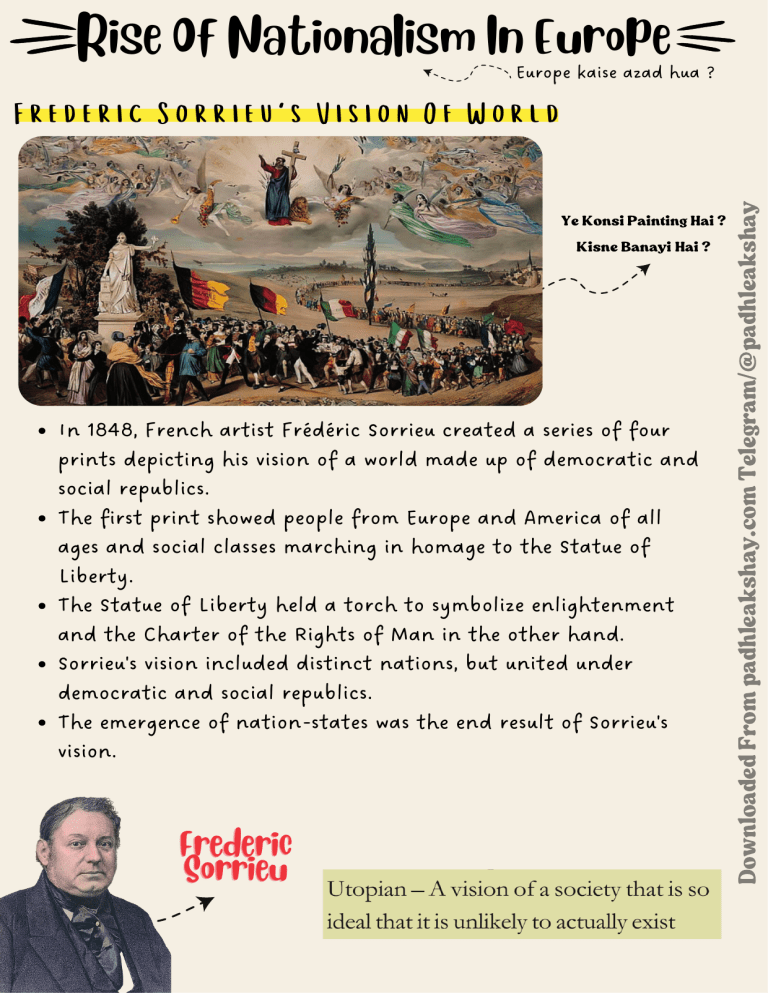
Rise Of Nationalism In Europe Europe kaise azad hua ? Frederic Sorrieu's Vision Of World Kisne Banayi Hai ? In 1848, French artist Frédéric Sorrieu created a series of four prints depicting his vision of a world made up of democratic and social republics. The first print showed people from Europe and America of all ages and social classes marching in homage to the Statue of Liberty. The Statue of Liberty held a torch to symbolize enlightenment and the Charter of the Rights of Man in the other hand. Sorrieu's vision included distinct nations, but united under democratic and social republics. The emergence of nation-states was the end result of Sorrieu's vision. Frederic Sorrieu yahskaelhdap@/margeleT moc.yahskaelhdap morF dedaolnwoD Ye Konsi Painting Hai ? The French Revolution and the Idea of the Nationdusre se baat rahe the , Par Log France me feeling ek Steps taken by French Revolutionaries to create the sense of Collective Belonging :- Mnemonic FECTIL F - French as the common language E - Equal rights in the constitution C - Change to a tricolor national flag T - Tax abolition on goods I - Internal customs duty elimination L - Loyalty to the fatherland NAPOLEANIC CODE OR CIVIL CODE OF 1804 The Civil Code of 1804, also known as the Napoleonic Code, was a comprehensive legal code introduced by Napoleon Bonaparte in France. It aimed to provide :Eliminated privileges based on birth. Abolished the feudal system. Removed the guild system. Improved transportation and communication systems. Secured the right to property. Mnemonic Ear is E - Eliminated privileges based on birth. A - Abolished the feudal system. R - Removed the guild system. I - Improved transportation and communication systems. S - Secured the right to property. moc.yahskelhdap morF dedaolnwoD Napolean france me dictatorship laya aur phir Napoleanic code bhi introduce kara... yahskaelhdap@/margeleT Adoption of a constitution that enshrined equal rights for all citizens. Introduction of a new tricolor national flag, replacing the former royal standard. Promotion of the concepts of citizenship (de citoyen) and loyalty to the fatherland (la Patrie). Abolition of internal customs duties on goods, facilitating free movement of capital. Adoption of French as the common language. yahskaelhdap@/TY Kaise ? There were Demerits too :Limited individual freedoms Patriarchal principles Lack of flexibility Inequality among social classes Limited representation Limited recognition of local customs Influence on other legal systems JCB KI Khudai se accha ye dekh lete hain ki Europe me nationalism kese bana ? Some Important factors that led to the Rise of Nationalism in Europe :Rise of Middle Class Spread of Ideology of Liberalism The New Script of Conservatism The Treaty of Vienna The Rise of Nationalism Aristocracy They owned estates and properties in both the countryside and townhouses. They spoke French and were a numerically small group. They were also united by a common way of life. Peasantry They were the majority in numbers. Middle Class Due to industrialization, new social groups such as the working class and middle class emerged. The middle class consisted of industrialists, businessmen, and professionals. Among the educated, liberal middle class, the idea of national unity gained popularity. yahskaelhdap@/margeleT moc.yahskelhdap morF dedaolnwoD The Making Of Nationalism In Europe yahskaelhdap@/TY DEMERITS Liberalism for the middle classes meant individual freedom and equality before the law. Economically, liberalism stood for free markets and the abolition of state-imposed restrictions on trade. Zollverein abolished tariffs and reduced trade barriers. A New Conservatism after 1815 Napolean Bonaparte Got Defeated in WaterLoo 1815. He was defeated by Britain , Prussia , Austria ,,Russia . Mnemonic B-Prak B - BRITAIN P - PRUSSIA R - RUSSIA A - AUSTRIA K - Killed yahskaelhdap@/margeleT moc.yahskelhdap morF dedaolnwoD In 1815, European governments were driven by conservatism, favoring monarchy, the Church, and social hierarchies. The Congress of Vienna restored the Bourbon dynasty to power and reversed Napoleon's territorial annexations. Representatives from Britain, Russia, Prussia, and Austria participated in the Congress of Vienna to settle Europe's affairs. Liberal nationalists critiqued the new conservative order and advocated for press freedom. yahskaelhdap@/TY Liberal Nationalism yahskaelhdap@/TY Treaty of Vienna (1815) THE AGE OF REVOLUTION (1830-48) Culture played a crucial role in shaping the idea of the nation. Art, poetry, stories, and music influenced nationalist sentiments. Romantic artists criticized reason and science while promoting emotions, intuition, and mystical feelings. They popularized the essence of the nation. Local folklore was collected and used to spread nationalism, even among those who couldn't read. Language was used as a means to resist foreign dominance. Hunger, Hardship and Revolts Population increased significantly across Europe. Job opportunities decreased due to the increase in population. Cities became overcrowded as people migrated to urban areas for work. There was stiff competition between handmade goods and cheaper machine-made goods. Food prices rose, and there were food shortages. Peasants and weavers revolted against the challenging economic and social conditions. yahskaelhdap@/margeleT moc.yahskelhdap morF dedaolnwoD Romantic Imagination & National Feeling In 1848, uprisings occurred in European countries involving the poor and middle classes. Middle-class movements in regions without independent nation-states like Germany, Italy, and Poland called for constitutionalism and national unification. The middle classes used growing popular unrest to push for the creation of a nation-state with parliamentary principles. GERMANY German middle class aimed to unify the different regions into a nation state. Monarchy, military and large landowners repressed the movement. Prussia took initiative in German unification. Architect of unification, Otto von Bismarck, used the Prussian army and bureaucracy. Prussian victory in three wars over seven years, including with Austria, Denmark and France, completed the German unification process. ITALY In the mid-19th century, Italy was divided into seven states ruled by different powers. Giuseppe Mazzini formed a secret society called Young Italy with a program for a unitary Italian republic. King Victor Emmanuel II of SardiniaPiedmont, with the help of Count Cavour and Giuseppe Garibaldi, led the movement to unify Italy's regions. yahskaelhdap@/margeleT moc.yahskelhdap morF dedaolnwoD Making of Germany & Italy yahskaelhdap@/TY The Revolution of Liberals 1848 Giuseppe Mazzini Mnemonic GESMM G - Genoa me Born Hua E -Exile (DeshNikala) me chale gye the in 1831 for attempting revolution in Liguria S - Secret Societies banai For Ex :- Young Italy In Marsellies & YoungEurope in Berne M - Monarch ke Bahut Bada Dushman !! M - Metternich ne Most Dangerous Enemy of Social Order Keh Diya REVOLUTION IN GREECE Greece, which had been a part of the Ottoman Empire since the 15th century, fought for independence. Nationalists in Greece received support from Western European artists, poets, and Greeks living outside Greece. Finally, in 1832, the Treaty of Constantinople recognized Greece as an independent nation. yahskaelhdap@/margeleT moc.yahskelhdap morF dedaolnwoD He was a member of the secret society of Carbonari. In 1831, he was exiled for attempting a revolution in Liguria. He founded two more underground societies - Young Italy in Marseilles and Young Europe in Berne. He believed that nations were intended by God to be the natural units of mankind and that Italy Giuseppe Mazzini should be a unified republic. He was described by Metternich as "the most dangerous enemy of social order." yahskaelhdap@/TY In 1859, Sardinia-Piedmont defeated Austria, and in 1860, armed volunteers led by Garibaldi liberated southern Italy and the kingdom of Two Sicilies. Italy was finally unified in 1871, with Victor Emmanuel II as its king, after Rome was vacated by France and became a part of Sardinia. Visualizing The Nation During the 18th and 19th century, artists found a way to personify nations as female figures, using them as allegories for the nation. The chosen female form did not represent any particular woman in real life, but instead became a symbol for the nation. In France, the female allegory was named Marianne, while in Germany, it was called Germania. Germania Female Allegory of Germany Marianne Female Allegory of France yahskaelhdap@/margeleT moc.yahskelhdap morF dedaolnwoD The people of British Isles had ethnic identities such as English, Welsh, Scot, and Irish. The English nation became more powerful and extended its influence over other nations. The Act of Union in 1707 between England and Scotland led to the formation of the United Kingdom of Great Britain, allowing England to impose its influence on Scotland. The Scottish Highlanders were banned from speaking their Gaelic language and wearing their national dress. A new 'British nation' was created by promoting a dominant English culture. yahskaelhdap@/TY UNIFICATION OF BRITAIN How the Balkans Became the Source of Nationalist Tension in Europe after 1871 :The Balkans was a region characterized by geographical and ethnic diversity. The region was primarily inhabited by Slavs and was under the control of the Ottoman Empire. Nationalist ideas began to spread throughout the Balkans. One by one, different nationalities in the region declared their independence through struggles. The Balkans later became one of the causes of the First World War. yahskaelhdap@/margeleT moc.yahskelhdap morF dedaolnwoD Nationalism & Imperialism yahskaelhdap@/TY IMPORTANT SYMBOLS *NOTE : Worksheet [Important Questions Of All typology with Answers) is provided as Seperate PDF on website padhleakshay.com* yahskaelhdap@/margeleT moc.yahskelhdap morF dedaolnwoD 1.Explain any three beliefs of the conservatism that emerged after 1815. (2011 D) 2.Explain the contribution of Otto von Bismarck in German unification. (2011 D) 3.Explain any three ways in which nationalist feelings were kept alive in Poland in the 18th and 19th centuries. (2011 OD) 4.Explain the contribution of Giuseppe Mazzini in spreading revolutionary ideas in Europe. 5.Describe any three reforms introduced by Napoleon in the territories he conquered. (2011 D) 6.Explain any three causes of conflict in the ‘Balkan area’ after 1871. (2011 OD) 7.How did the local people in the areas conquered by Napoleon react to French rule? Explain. 8.Explain the conditions that were viewed as obstacles to the economic exchange and growth by the new commercial classes during the nineteenth century in Europe. (2014 OD) 9.Describe the events of French Revolution which had influenced the people belonging to other parts of Europe. (2015 D) 10.How did nationalism develop through culture in Europe? Explain. (2015 OD, 2013 OD) 11.Describe any three steps taken by the French revolutionaries to create a sense of collective identity amongst the French people. (2017 D) yahskaelhdap@/TY PYQs


